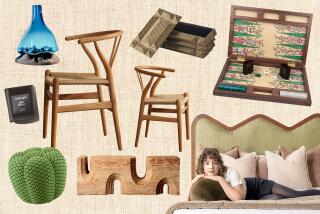Fading to Black for Home Furnishings
- Share via
Black-tie season at the White House, albeit with boots, has begun. Black velvet dresses have returned to couture runways. Who can be surprised that black has turned up in the parlor, too?
“Color it black,” advises the September issue of Martha Stewart Living.
The cover line is supported by photos of newly ebonized furnishings in the guest quarters of Stewart’s Connecticut house, which has long served as a laboratory for her style-setting ideas.
Stewart appears to be in a sober, no-nonsense phase. Window shades are black as bat wings. Sofa and lampshade are swathed in black horsehair and silk. Antiques and flea-market finds have been painted ebony tones. Even the fruits and flowers on the dining table are as deep--or grim--a shade as nature could provide: black raspberries, grapes and cherries set off by bunches of black scabiosas.
After dipping into blackish shades of charcoal, aubergine, stone brown and bronze, “it was easier to see the integrity” of the furnishings, the magazine reports. And they looked more elegant against cream-colored walls.
Stewart’s taste has always run to caviar. But her switch--in this case, from weathered white shabby chic to dramatic black--is right in tune with the Zeitgeist .
“There is definitely an increase in formality in interior design,” says Melanie Wood, a design consultant for the home fashion industry and past president of the Alexandria, Va.-based Color Marketing Group. And she sees a dramatic increase in the use of black tones, from walls to furnishings.
Decorative trends tend to reflect the world at large. The latest palette shift comes amid a depressed economy, a resurgence of conservatism and a discredited dot-com business model that favored “casual Fridays” and sleeping under desks.
“We’ve almost taken casual as far as we can go,” says Wood.
In interior design terms, reaching for black reflects “a sense that we need to go back to safer, better times” and to get serious about business, Wood says. “Things aren’t always as easy as they seemed for the last couple of years.”
It was only two years ago, while the e-conomy was perking nicely, that design companies followed fashion houses down the bold-color path. After decades of attachment to modernist blacks and grays, they indulged in molten fuchsia, pink and yellow. Freshly lacquered cabinets glowed like red-hot stock portfolios. This spring, hot-pink Pucci prints and confetti-orange hues dominated the Milan Furniture Fair. Those designs have barely come to market. But the party may be winding down.
“Color helps us reflect who we are and even how we feel,” says Jay de Sibour, who heads the Color Marketing Group. “In boom times, when people feel good and comfortable with their disposable income, you will tend to see a lightening or brightening of the palette.” Conversely, when the economy falters, so does confidence about investing in hot pink or orange.
“Black is very classic,” says Wood. “Classicism is something we see happening. We need to be a little more conservative in our private and business lives.”
Politics aside, Crate & Barrel is offering a collection of wood furniture in a waxed black distressed finish. (The look was dubbed “Inferno” well before the dot-com economy created one.) By October, Target stores will be selling a spiffy new coal-black toaster from Michael Graves. (His earlier model was sparkling white.) At Chiasso, the contemporary design chain, whimsical housewares in chartreuse and cobalt blue plastic are still in stock. But the latest catalog offers bath accessories in black-glazed bone china.
However basic, black has never been simple. Wallpaper magazine’s new fashion biannual, called Spruce, researched black dyes for its premiere issue. Conclusion: “Despite the resurgence of colour and prints over the past few seasons, black is still basic, but rarely the same thing twice.”
Different textiles hold color differently, which explains why the all-black wardrobe never matched.
As Spruce puts it, “If this essential shade is supposed to declare confidence and authority--think 1980s power dressing, court judges and rocker rebellion--then a faded graying tone implies that you may be washed up, too.”
A black sofa may fade as rapidly as a cashmere coat. But that may not be the greatest thing to fear from this trend. Far worse would be the return of the formal parlor.


